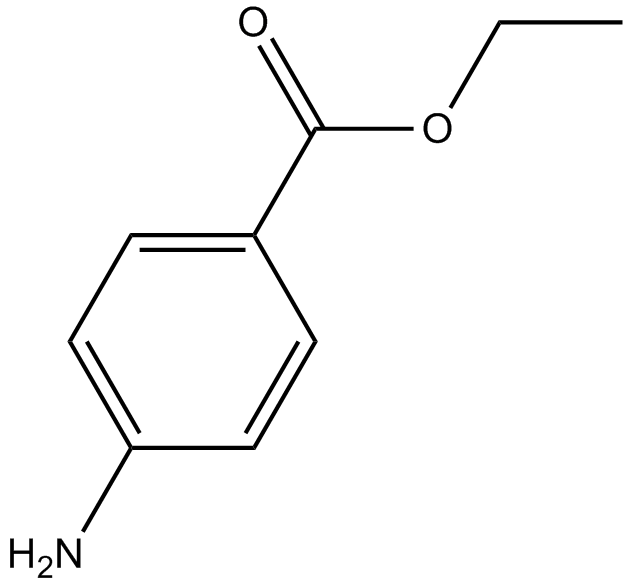Benzocaine (Synonyms: Ethyl 4-Aminobenzoate, H-4-Abz-OEt, NSC 4688, NSC 41531) |
| Catalog No.GC13125 |
Sodium channel inhibitor
Products are for research use only. Not for human use. We do not sell to patients.

Cas No.: 1994/9/7
Sample solution is provided at 25 µL, 10mM.
Benzocaine shares a common receptor with all other local anesthetics (LAs) in the voltage-gated Na+ channel, with an IC50 of 0.8 mM tested with a potential of +30 mV.
Benzocaine blocks μ1 wild-type Na+ currents in a dose-dependent Manner. The Benzocaine concentration that inhibits 50% of Na+ currents (IC50) is estimated to be about 0.8 mM when a test potential of +30 mV is applied. The slope of the h∞ curve is also significantly reduced by benzocaine (from 6.6 to 9.9 mV). Mutation of μ1-N1584A also significantly increases the potency of Benzocaine. At 1 mM, Benzocaine blocks about 55% of wild-type Na+ current but about 95% of μ1-N1584A mutant current. Benzocaine also appears to bind more strongly to its LA receptor in the N1584A mutant than in the wild type[1]. The inhibition of Ca2+ uptake occurres at lower Benzocaine concentration (IC50=40.3±1.2mM) than that affecting the enzymatic activity[2].
A common Benzocaine-containing anesthetic is topically applied to the following species: dogs, domestic shorthair cats, Long-Evans rats, Sprague-Dawley rats, ferrets, rhesus monkeys, cynomolgus monkeys, owl monkeys, New Zealand White rabbits, miniature pigs, ICR mice, C3H mice, and C57BL/10SnJ mice. All animals, except mice and rats, receive a 2-second spray to the mucous membranes of the nasopharynx for an estimated dose of 56 mg. A 2-second spray to rodents' oral mucous membranes delivers too great a volume of fluid for these animals. The study is repeated in dogs several months later to confirm low response. Response to Benzocaine spray is observed in most animals tested, with response peaking between 15 and 30 minutes after dosing[3].
References:
[1]. Wang GK et al. A common local anesthetic receptor for benzocaine and etidocaine in voltage-gated mu1 Na+ channels. Pflugers Arch. 1998 Jan;435(2):293-302.
[2]. Davis JA, et al. Benzocaine-induced methemoglobinemia attributed to topical application of the anesthetic in several laboratory animal species. Am J Vet Res. 1993 Aug;54(8):1322-6.
[3]. Di Croce D et al. Drug action of benzocaine on the sarcoplasmic reticulum Ca-ATPase from fast-twitch skeletal muscle. Naunyn Schmiedebergs Arch Pharmacol. 2015 Nov;388(11):1163-70.
Average Rating: 5 (Based on Reviews and 6 reference(s) in Google Scholar.)
GLPBIO products are for RESEARCH USE ONLY. Please make sure your review or question is research based.
Required fields are marked with *




















